La Chaux-de-Fonds / Le Locle, Watchmaking Town Planning: The town La Chaux-de-Fonds and its sister city Le Locle are situated close to one another in the Jura Mountains in Switzerland, about 66 km from Bern, the capital city of Switzerland. The watch-making industry was brought to Le Locle in the 17th century by a self-taught watchmaker, he encouraged the local farmers of La Chaux-de-Fonds and Le Locle to start manufacturing watch components for him during the long winters. La Chaux-de-Fonds was completely destroyed by a fire in 1794. The town was rebuilt in a chessboard pattern. Le Locle was rebuilt after a fire in 1833, taking La Chaux-de-Fonds as an example, it was also rebuilt in a chessboard pattern. This urban design was ideal for the role as watchmaking cities. Due to this town planning, the artisanal production of a cottage industry turned into the more concentrated factory production in the 19th and 20th centuries. At the end of the 19th century, La Chaux-de-Fonds and Le Locle enjoyed great prosperity thanks to the watch making industry. This important centre of the watch making industry is known as the Watch Valley. Karl Marx described La Chaux-de-Fonds as a 'huge factory town' in his famous work 'Das Kapital'. La Chaux-de-Fonds is also a famous centre of the Art Nouveau. Car manufacturer Chevrolet and architect Le Corbusier were born in La Chaux-de-Fonds. In 1912, La Maison Blanche and La Villa Turque in La Chaux-de-Fonds were designed by Le Corbusier. La Chaux-de-Fonds / Le Locle, Watchmaking Town Planning gained the status as a UNESCO World Heritage in 2009.
www.werelderfgoedfotos.nl © Copyright World Heritage Photos

La Chaux-de-Fonds / Le Locle, Watchmaking Town Planning: The former town hall of Le Locle was built in 1839-1841. It is decorated on the outside with frescoes, on the inside with tempera paintings. After fires in the 18th and 19th centuries, the towns La Chaux-de-Fonds and Le Locle were rebuilt in a chessboard pattern. The open planning of the urban space has encouraged the continual development of the watchmaking towns from the 18th century until today.
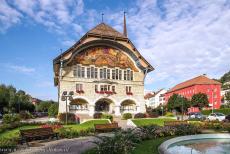
La Chaux-de-Fonds / Le Locle, Watchmaking Town Planning: The former town hall of Le Locle was built in 1839-1841. It is decorated on the outside with frescoes, on the inside with tempera paintings. After fires in the 18th and 19th centuries, the towns La Chaux-de-Fonds and Le Locle were rebuilt in a chessboard pattern. The open planning of the urban space has encouraged the continual development of the watchmaking towns from the 18th century until today.
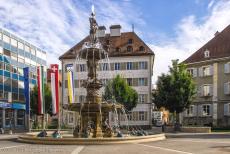
La Chaux-de-Fonds / Le Locle, Watchmaking Town Planning: La Grande Fontaine in La Chaux-de-Fonds, the iconic fountain was built in 1888 and was the first decorative monument in La Chaux-de-Fonds, the fountain was built to commemorate the arrival of the first running water in the town. The water is brought to the fountain via an imposing underground piping system from the springs in Areuse Gorge in the Jura Mountains.
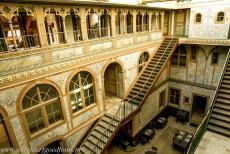
La Chaux-de-Fonds / Le Locle, Watchmaking Town Planning: The Old Riding school of La Chaux-de-Fonds, the L'Ancien Manège. The Old Riding school, a enormous rectangular hall measuring 35 meters by 20 meters, was inaugurated in 1857. The walls of the indoor courtyard of the Old Riding school are decorated with paintings. The building is accessible for visitors.
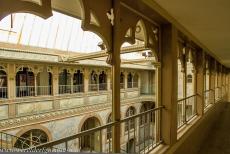
La Chaux-de-Fonds / Le Locle, Watchmaking Town Planning: The Old Riding school of La Chaux-de-Fonds, the L'Ancien Manège. Between 1867 and 1869, the riding school was converted into a residential complex with both apartments and family homes. In 1902, the interior courtyard was decorated with imitation marble and painted plant motifs. The building was renovated in 1985. The riding school also houses a restaurant.
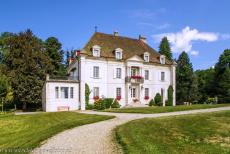
La Chaux-de-Fonds / Le Locle, Watchmaking Town Planning: The Musée d'Horlogerie du Le Locle, the Le Locle Watch Museum, is located in Château des Monts. The watch museum houses a extraordinary collection of watches and clocks. The garden features several sundials and large sculptural clocks. The museum is situated about one km north of the city centre of Le Locle.
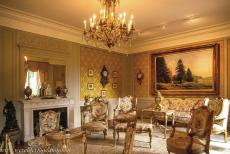
La Chaux-de-Fonds / Le Locle, Watchmaking Town Planning: The interior of Château des Monts in Le Locle. The Le Locle Watch Museum is situated in the Château des Monts, a mansion built in 1790. The Le Locle Watch Museum houses an exceptional collection of watches and clocks. The small towns of La Chaux-de-Fonds and Le Locle are the centre of Swiss watchmaking.
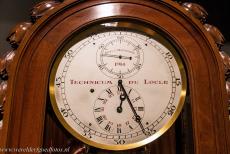
La Chaux-de-Fonds / Le Locle, Watchmaking Towns: One of the clocks of the Le Locle Watch Museum, Musée d'Horlogerie du Le Locle. The clock was made at the Technicum du Locle, today the Technicum Neuchâtelois, a prestigious watchmaker school. There is also a watch museum in the town of La Chaux-de-Fonds: International Museum of Horology.
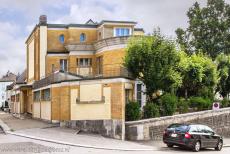
La Chaux-de-Fonds / Le Locle, Watchmaking Town Planning: La Villa Turque, the Turkish Villa, is situated in La Chaux-de-Fonds. The villa, also known as the Villa Anatole Schwob, was designed by Le Corbusier in 1916 for the watchmaker Anatole Schwob. The design for the Turkish Villa was influenced by the Ottoman architecture Le Corbusier saw during his travels through Turkey.
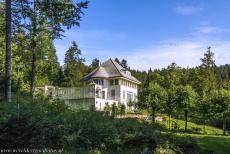
La Chaux-de-Fonds / Le Locle, Watchmaking Town Planning: In 1912, Le Corbusier designed and built a house in La Chaux-de-Fonds, La Maison Blanche, the White House. La Maison Blanche is also known as Villa Jeanneret-Perret. Le Corbusier was born as Charles Edouard Jeanneret-Gris, he assumed the pseudonym Le Corbusier when he moved to Parish in 1917.
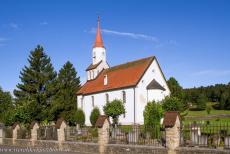
La Chaux-de-Fonds / Le Locle, Watchmaking Town Planning: The church of Éplatures is situated between the two watchmaking towns of Le Locle and La Chaux-de-Fonds. The church was built in the period 1847-1852. La Chaux-de-Fonds / Le Locle, Watchmaking Town Planning, gained the status as a UNESCO World Heritage in 2009.
